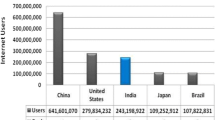Abstract
A proper access control mechanism is the need of the hour, as the data stored in the cloud needs to be protected securely. Generally, a multifactor authentication (MFA) is preferred, one that needs the authentication of two or even more aspects based on identity, information and facts, and ownership which needs to check the value and correctness of users while logging into cloud services. Clouds such as Amazon, Google, Microsoft etc. generally have an additional attribute, one that is automatically made inactive. The MFA are intrusive and untrusted cloud servers can access user’s sensitive information. The objective of this work is to use a trust model which can identify client device. For instance, if the client device is public then a biometric authentication is provided. Based on the client device, trust is computed and the authentication process will be reduced from multifactor to single factor. Experimental results show that improved performance is attained by the proposed trust based MFA.


Similar content being viewed by others
References
Chitra, S., Madhusudhanan, B., Sakthidharan, G.R., Saravanan, P.: Local minima jump PSO for workflow scheduling in cloud computing environments. In: Advances in Computer Science and its Applications, vol. 279, pp. 1225–1234. Springer, Berlin (2014)
Joseph, A.O., Kathrine, J.W., Vijayan, R.: Cloud security mechanisms for data protection: a survey. Int. J. Multimed. Ubiquitous Eng. 9(9), 81–90 (2014)
Yang, Y.T., Borg, K.: Regulatory privacy protection for biomedical cloud computing. Bei**g L. Rev. 3, 145 (2012)
Lin, Y.C., Yu, C.S., Lin, Y.J.: Enabling large-scale biomedical analysis in the cloud. BioMed Res. Int. 2013, 1–6 (2013)
Rahman, A.A.R.A.: A multi-factor authentication scheme using attributed access control and message context. Inter. J. Adv. Res. Comp. Comm. Eng. 5(5), 267–270 (2016)
Praveena, T.L., Ramachandran, V.: Attribute based multifactor authentication for cloud applications. Int. J. Comput. Appl. 80(17), 37–40 (2013)
Soni, P., Sahoo, M.: Multi-factor authentication security framework in cloud computing. Int. J. Adv. Res. Comput. Sci. Softw. Eng. 5(1), 1065–1071 (2015)
Ullah, S., Xuefeng, Z., Feng, Z.: TCLOUD: a multi-factor access control framework for cloud computing. Int. J. Secur. Appl. 7(2), 15–26 (2013)
Jakimoski, K.: Security techniques for data protection in cloud computing. Int. J. Grid Distrib. Comput. 9(1), 49–56 (2016)
Sinha, M., Silakari, S., Pandey, R.: Trust based mechanism for secure cloud computing environment: a survey. Int. J. Eng. Sci. Invent. 5(3), 17–23 (2016)
Mansour, A., Sadik, M., Sabir, E.: Multi-factor authentication based on multimodal biometrics (MFA-MB) for cloud computing. In: 2015 IEEE/ACS 12th International Conference of Computer Systems and Applications (AICCSA), pp. 1–4. IEEE (2015)
Butoi, A., Tomai, N.: Secret sharing scheme for data confidentiality preserving in a public-private hybrid cloud storage approach. In: 2014 IEEE/ACM 7th International Conference on Utility and Cloud Computing (UCC), pp. 992–997. IEEE (2014)
Yang, B., Chu, H., Li, G., Petrovic, S., Busch, C.: Cloud password manager using privacy-preserved biometrics. In: 2014 IEEE International Conference on Cloud Engineering (IC2E), pp. 505–509. IEEE (2014)
Noor, T.H., Sheng, Q.Z., Yao, L., Dustdar, S., Ngu, A.H.: CloudArmor: supporting reputation-based trust management for cloud services. IEEE Trans. Parallel Distrib. Syst. 27(2), 367–380 (2016)
Soares, L.F., Fernandes, D.A., Freire, M.M., Inácio, P.R.: Secure user authentication in cloud computing management interfaces. In: 2013 IEEE 32nd International Performance Computing and Communications Conference (IPCCC), pp. 1–2. IEEE (2013)
Gourkhede, M.H., Theng, D.P.: Analysing security and privacy management for cloud computing environment. In: 2014 Fourth International Conference on Communication Systems and Network Technologies (CSNT), pp. 677–680. IEEE (2014)
Panse, D., Haritha, P.: Multi-factor authentication in cloud computing for data storage security. Int. J. Adv. Res. Comput. Sci. Softw. Eng. 4(8), 629–634 (2014)
Soni, P., Sahoo, M.: Multi-factor authentication security framework in cloud computing. Int. J. Adv. Res. Comput. Sci. Softw. Eng. 5(1), 1065–71 (2015)
Crane, S.: Simple-homomorphic-encryption. https://github.com/rinon/Simple-Homomorphic-Encryption (2012)
Liu, W., Uluagac, A.S., Beyah, R.: MACA: A privacy-preserving multi-factor cloud authentication system utilizing big data. In: 2014 IEEE Conference on Computer Communications Workshops (INFOCOM WKSHPS), pp. 518–523. IEEE (2014)
Author information
Authors and Affiliations
Corresponding author
Rights and permissions
About this article
Cite this article
Anakath, A., Rajakumar, S. & Ambika, S. Privacy preserving multi factor authentication using trust management. Cluster Comput 22 (Suppl 5), 10817–10823 (2019). https://doi.org/10.1007/s10586-017-1181-0
Received:
Revised:
Accepted:
Published:
Issue Date:
DOI: https://doi.org/10.1007/s10586-017-1181-0




